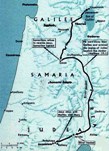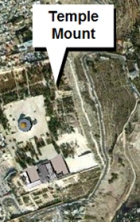Jesus attacks the money-changers
Questions for Bible study groups
- What was the Temple in Jerusalem like at the time of Jesus?
- What sort of people were there on that day?
- What did Jesus do? Why were his actions so shocking?
- Why was Jesus so angry?
- What was the reaction of the authorities?
In brief: There was an angry confrontation between Jesus and the money-changers and guards in the great Temple of Jerusalem. Jesus said they had turned the sacred place into a den of robbers, and he evicted them.
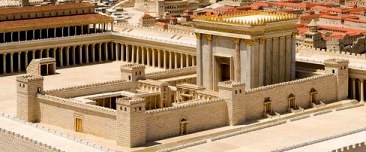
Reconstruction of the central part of the Temple of Jerusalem, built by King Herod the Great. The courtyard outside the walled area is the Court of the Gentiles, where Jesus attacked the money-changers
The Temple in Jerusalem
What was it like? The first thing Jesus did when he got to Jerusalem was to go to the great Temple, newly built in shining white marble, and vast, about 450mx300m. Jesus probably offered sacrifice there and prayed. But what we hear about is the action that happened in the Court of the Gentiles.
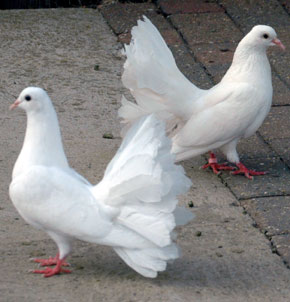 There was a market there selling sacrificial animals and birds. There was also a money exchange, since the Temple dues had to be paid in Tyrian coinage, and most people had Jerusalem coinage only. This meant:
There was a market there selling sacrificial animals and birds. There was also a money exchange, since the Temple dues had to be paid in Tyrian coinage, and most people had Jerusalem coinage only. This meant:
- that the atmosphere in the Court of the Gentiles was like an oriental bazaar where merchants haggled with Jewish pilgrims – like souvenir shops clustered round modern-day cathedrals
- the Temple-appointed merchants/money changers probably cheated or over-charged people.
To add to the unholy din, tradespeople used the Court of the Gentiles as a short-cut between the city and the Mount of Olives – the Temple precincts could be entered from all four sides.
All this was harmless enough, but it meant that the Court of the Gentiles was something less than a place of prayer. Jesus was not the only one to object: there was widespread criticism of the 1st-century Temple scene among Jewish writers.
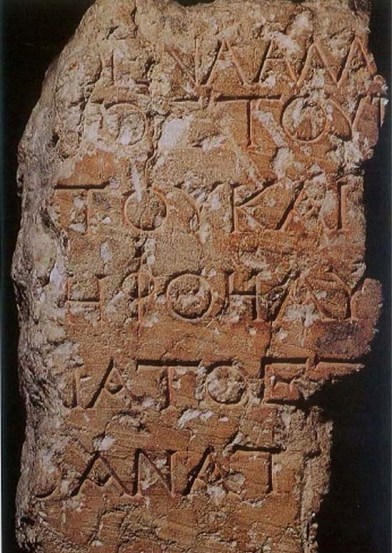 At right is an excavated stone sign found at the site of the Temple of Jerusalem. It advises that Gentiles must not enter past this point, on pain of death, and was presumably at the entrance separating the Court of the Women from the Court of the Gentiles (see ground plan below).
At right is an excavated stone sign found at the site of the Temple of Jerusalem. It advises that Gentiles must not enter past this point, on pain of death, and was presumably at the entrance separating the Court of the Women from the Court of the Gentiles (see ground plan below).
What sort of people were there on that day?
Josephus, the Jewish historian, says
The outer court was open to all, foreigners included; women during their menstruation were alone refused admission. To the second court all Jews were admitted and, when uncontaminated by any impurity, their wives; to the third male Jews, if clean and purified; to the fourth the priests robed in their priestly vestments. The sanctuary was entered only by the ruling priests, clad in the raiment peculiar to themselves. (Josephus, Against Apion, 2.8:104)
When did it happen? John puts this event at the beginning of Jesus’ ministry, and the other three evangelists place it right at the end, just before Jesus was killed. Who is correct? And does it matter?
It is quite possible that Jesus cleansed the Temple twice. We know he went there a number of times. Several years may separate the two cleansings – to judge by Jesus’ anger in Matthew, the first incident had not been effective, which is why Jesus was so angry.
But we also know John tried to supplement the other gospels, and this may account for the differences. John may have deliberately used a different narrative structure, one that did not rely on historical sequence. The message may have been more important to him than the order in which events happened.
Read the blue text at end of page
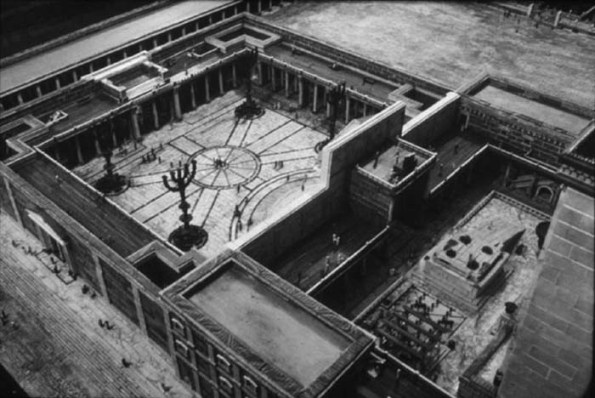
View from above of the Women’s Court (upper left with patterned floor) and surrounding Court of the Gentiles in the Temple at the time of Jesus (from a reconstruction built by Alec Gerrard)
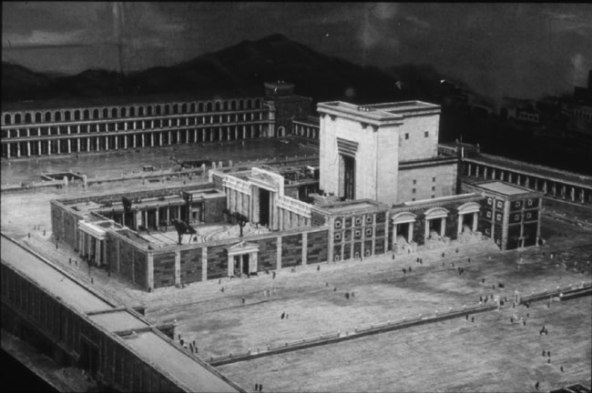
Alex Gerrard’s model of the Jerusalem Temple shows how large the Court of the Gentiles was
What Jesus did: his shocking actions
How many people were there?
The incident took place in a very large area – so large that many people would have been unaware of what was happening. Thousands of pilgrims were crowded into the courtyard, together with the tables of the money changers and stalls to keep the sacrificial animals. There were Temple police who kept order; a large number of them would have been present at this major festival. Had there been a large-scale fracas, these police would certainly have acted. So Jesus could only have attacked some of the money-changers’ tables.
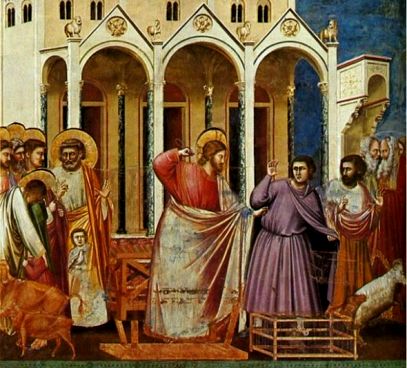 But the scale of what happened is unimportant, both to us and to the disciples who witnessed it. Its real significance lay in two things:
But the scale of what happened is unimportant, both to us and to the disciples who witnessed it. Its real significance lay in two things:
- Jesus openly showed his disgust with religious practice polluted by money-grubbing
- it gave Jesus’ enemies, the high clergy and the aristocracy of Jerusalem, the chance to bring a grave and specific charge against him.
What was happening?
You can understand this passage in a number of ways:
Jesus saw trade in the Temple as a desecration of its true purpose so, maybe with the help of others, he tried to shut down the trade in sacrificial animals and the money-changing that was going on
He saw the Court of the Gentiles as a sacred place, part of God’s Temple. The general hullabaloo of the area made this impossible, and it angered him
He made an assessment that the trade and money changing exploited people, especially the poor, by making excessive charges, so he intervened
Jesus thought the priests and Temple personnel were abusing their sacred roles by being involved in business in a sacred area
There was already a conflict going on between the Sanhedrin and the High Priest Caiaphas in AD30, when Caiaphas allowed traders to set up markets in the Court of the Gentiles as punitive competition against markets controlled by the Sanhedrin.
Read the red text at end of page
What Jesus said: why was he so angry?
For this part of the story, see the red text in the Gospel passages at the bottom of this page.
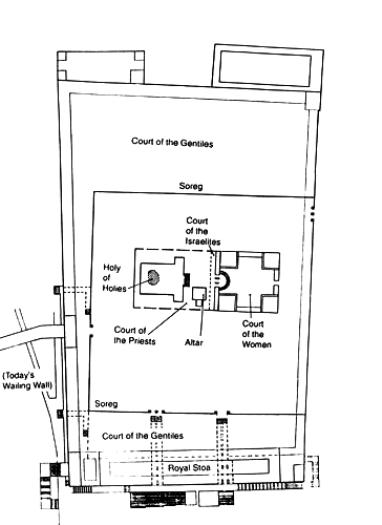 What Jesus said at the time is as important as what he did. He was objecting to trade being carried out in the Temple not because of profiteering, but because the Temple precincts have been turned into a place of business, thus violating its divinely intended purpose. He bases this on the words of the prophet Isaiah ‘my house shall be called a place of prayer’. Now it is a ‘den of thieves’- again, a phrase from another prophet, Jeremiah 7:11.
What Jesus said at the time is as important as what he did. He was objecting to trade being carried out in the Temple not because of profiteering, but because the Temple precincts have been turned into a place of business, thus violating its divinely intended purpose. He bases this on the words of the prophet Isaiah ‘my house shall be called a place of prayer’. Now it is a ‘den of thieves’- again, a phrase from another prophet, Jeremiah 7:11.
To emphasise this point, all of the gospel writers include Old Testament prophecies in their description of the event.
Jesus’ references to Isaiah and Jeremiah would have been provocative and offensive to the priests, since he was using the words of Scripture against them. Only the presence of so many supportive pilgrims stopped them from taking immediate and public action against him.
The priests showed their piety by saying that Jesus should have been shocked by the sing-song words of the children calling him ‘Son of David’, and should have stopped them. But the children had spoken the truth, and Jesus accepted the title.
Jesus was by no means alone in his criticism of the ‘system’. Many Jews viewed the high priesthood as corrupt. The ‘Testament of Moses’, written at about the same time, describes the high priesthood:
They consume the goods of the poor, saying their acts are according to justice (while in fact they are simply) exterminators, deceitfully seeking to conceal themselves so that they will not be known as completely godless because of their criminal deed (committed) all day long, saying “We shall have feasts, even luxurious winings and dinings. Indeed, we shall behave ourselves as princes.” They, with hand and mind, touch impure things, yet their mouths will speak enormous things, and they will even say “Do not touch me, lest you pollute me in the position I occupy.”
Read the green text at end of page
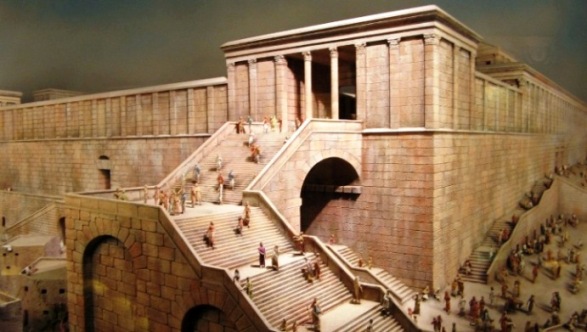
A reconstruction of one of the entrances to the Temple area;
this entrance led to the Court of the Gentiles
Reaction of the authorities
For this part of the story, see the black text in Gospel passages at the end of this page.
Jesus entered Jerusalem on a happy, triumphant note (see Jesus’ Entry into Jerusalem). But now an escalating series of accusations and charges began. His actions and words in the Temple that day triggered the events that led to his death a few days later. But at that moment in the Court of the Gentiles the authorities could not take action against him, because
- he was not only popular, he was very much in view when he visited the Temple precincts. There was a crowd around him all the time, and any attempt at arrest could cause a riot.
- every evening during his last visit to Jerusalem, Jesus went out of the city as darkness fell – possibly to the house of Mary, Martha and Lazarus in Bethany. This made it difficult to arrest him. Perhaps he felt unsafe in the city. But there may have been a more prosaic reason for his departure each evening: Jesus, along with the thousands of other Passover pilgrims, would find it hard to find lodgings for himself and his followers – or perhaps this large group could not afford high-priced accommodation.
Read the black text at end of page
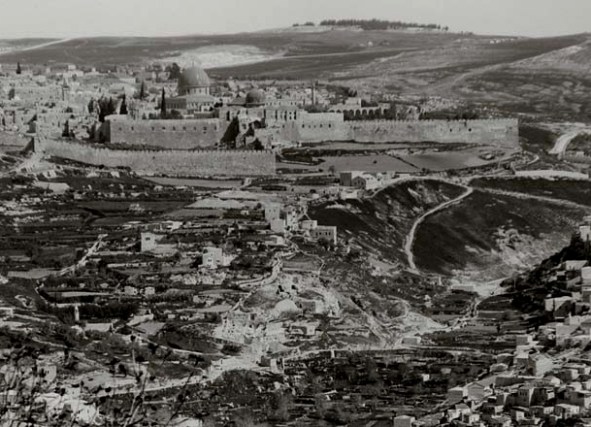
Photo of 19th century Jerusalem; at the end of each day Jesus probably left the city, crossed the Kidron Valley (lower right) and walked up the Mount of Olives (extreme lower right corner)
Summary
Jesus mounted a protest against the commercial activity going on in the Temple. The money-changing and selling of sacrificial animals interfered with the proper use of this most sacred of spaces, and Jesus was outraged at a sacrilegious use of this place of prayer. He took sudden, dramatic action. It was not the animal vendors and money-changers he criticised as much as the Temple establishment who allowed it. The ruling priests, especially the high priest himself, gave permission for these commercial activities to take place. They were ultimately responsible for this desecration of a holy place.
What happened next? See Betrayal by Judas
Return to top
What the Gospels say
The Jerusalem Temple: read the blue text
2 The dramatic actions of Jesus: read the red text
3 What Jesus said: read the green text
4 The reactions of the Temple authorities: read the black text
Mark 11:15-19
15 And they came to Jerusalem. And he entered the temple and began to drive out those who sold and those who bought in the temple, and he overturned the tables of the money-changers and the seats of those who sold pigeons; 16 and he would not allow any one to carry anything through the temple. 17 And he taught, and said to them, “Is it not written, ‘My house shall be called a house of prayer for all the nations’? But you have made it a den of robbers.”
18 And the chief priests and the scribes heard it and sought a way to destroy him; for they feared him, because all the multitude was astonished at his teaching. 19 And when evening came they went out of the city.
Matthew 21:12-17
12 And Jesus entered the temple of God and drove out all who sold and bought in the temple, and he overturned the tables of the money-changers and the seats of those who sold pigeons.
13 He said to them, “It is written, ‘My house shall be called a house of prayer’; but you make it a den of robbers.”
14 And the blind and the lame came to him in the temple, and he healed them.
15 But when the chief priests and the scribes saw the wonderful things that he did, and the children crying out in the temple, “Hosanna to the Son of David!” they were indignant; 16 and they said to him, “Do you hear what these are saying?”
And Jesus said to them, “Yes; have you never read, ‘Out of the mouth of babes and sucklings thou hast brought perfect praise’?”
17 And leaving them, he went out of the city to Bethany and lodged there.
Luke 19:45-48
And he entered the temple and began to drive out those who sold, saying to them, “It is written, ‘My house shall be a house of prayer’; but you have made it a den of robbers.”
46 And he was teaching daily in the temple. 47 The chief priests and the scribes and the principal men of the people sought to destroy him 48 but they did not find anything they could do, for all the people hung upon his words.
John 2:13-16
John 2:13 The Passover of the Jews was at hand, and Jesus went up to Jerusalem.
14 In the temple he found those who were selling oxen and sheep and pigeons, and the money-changers at their business. 15 And making a whip of cords, he drove them all, with the sheep and oxen, out of the temple; and he poured out the coins of the money-changers and overturned their tables.
16 And he told those who sold the pigeons, “Take these things away; you shall not make my Father’s house a house of trade.”
You might like to compare the parallel accounts of the births of Jesus and John the Baptist in Luke’s gospel. You can find the gospel texts at http://www.womeninthebible.net/Elizabeth_bible_text.htm
Notice especially statements about
the pregnancy reaching term, Luke 1.57 and 2.6
the birth statement, Luke 1.57 and 2.7
marvelling onlookers, Luke 1.63 and 2.18
the taking to heart of what had happened, Luke 1.66 and 2.19
circumcision and name-giving, Luke 1.59 and 2.21
John’s birth is clearly a prelude to the birth of Jesus.

